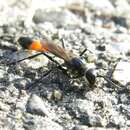Brief Summary
provided by Catalog of Hymenoptera in America North of Mexico
The behavior of these slender, elongate wasps has been studied by a host of observers. All species are fossorial, usually solitary in nesting habits, although a few extralimital species are gregarious nesters. Typically, the nest consists of a short, oblique to perpendicular burrow terminating in a single cell, although 2-celled nests have been reported in two species. Usually, the nest is dug before prey is obtained, but two species have been reported as capturing prey before constructing the nest. ~The prey used by Ammophila consists usually of hairless larvae although sparsely to densely haired larvae may be used occasionally. Lepidopterous larvae are frequently provided, but occasionally hymenopterous (sawfly) larvae are used. There is one record of weevil larvae being preyed upon by azteca Cam. which also uses lepidopterous and sawfly larvae. It is probable that caterpillars are the preferred prey, and that sawfly or weevil larvae are used only when there is not a ready supply of caterpillars. Wasps using larger larvae for prey, store only one per nest; those using smaller larvae may provide as many as 11 per cell. Most species are mass provisioners, but several practice progressive provisioning. Three species, including our native azteca, are known to maintain several nests simultaneously which are provisioned progressively. ~The Peckhams observed one specimen of urnaria Dahlb. using a pebble to tamp the earth in the nest closure. They contended that this constituted improvisation of a tool and intelligent use of it. Subsequent observations on other species demonstrate conclusively that the supposed tool-using behavior is not an intelligent act but the culmination of a succession of instinctive behavioral traits.
- bibliographic citation
- Catalog of Hymenoptera in America North of Mexico. 1979. Prepared cooperatively by specialists on the various groups of Hymenoptera under the direction of Karl V. Krombein and Paul D. Hurd, Jr., Smithsonian Institution, and David R. Smith and B. D. Burks, Systematic Entomology Laboratory, Insect Identification and Beneficial Insect Introduction Institute. Science and Education Administration, United States Department of Agriculture.

